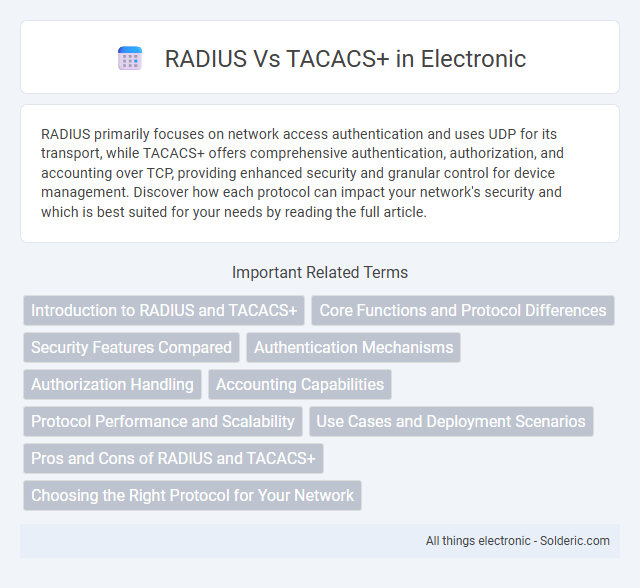RADIUS primarily focuses on network access authentication and uses UDP for its transport, while TACACS+ offers comprehensive authentication, authorization, and accounting over TCP, providing enhanced security and granular control for device management. Discover how each protocol can impact your network's security and which is best suited for your needs by reading the full article.
Comparison Table
| Feature | RADIUS | TACACS+ |
|---|---|---|
| Protocol Type | UDP-based | TCP-based |
| Authentication | Combined with authorization and accounting | Separate from authorization and accounting |
| Encryption | Encrypts only password in access-request packets | Encrypts the entire payload |
| Port Number | 1812 (Authentication), 1813 (Accounting) | 49 |
| Usage | Network access control (VPN, Wi-Fi) | Device administration and management |
| Flexibility | Less granular control | Supports separate authentication, authorization, and accounting |
| Vendor Support | Widespread support across vendors | Primarily Cisco and compatible vendors |
| Accounting | Built-in accounting features | Available but less emphasized |
Introduction to RADIUS and TACACS+
RADIUS (Remote Authentication Dial-In User Service) and TACACS+ (Terminal Access Controller Access-Control System Plus) are popular protocols used for network authentication, authorization, and accounting. RADIUS combines authentication and authorization together while focusing on efficiency in network access services, commonly deployed in ISP environments. TACACS+ separates authentication, authorization, and accounting processes, providing more granular control and security, making it ideal for managing device administration in enterprise networks.
Core Functions and Protocol Differences
RADIUS (Remote Authentication Dial-In User Service) primarily handles authentication, authorization, and accounting for network access, operating over UDP with simpler transport and encryption mechanisms. TACACS+ (Terminal Access Controller Access-Control System Plus) separates authentication, authorization, and accounting processes, uses TCP for reliable communication, and provides enhanced security with full packet encryption. Your choice depends on whether you prioritize widespread compatibility and efficiency (RADIUS) or granular control and security in device management (TACACS+).
Security Features Compared
RADIUS and TACACS+ differ significantly in their security features, with TACACS+ offering more granular control by separating authentication, authorization, and accounting processes. TACACS+ uses full encryption for the entire packet, providing robust protection against eavesdropping, whereas RADIUS only encrypts the user's password, leaving other data exposed. Your choice should consider TACACS+ for enhanced security in managing device administration and RADIUS for simpler, network access-focused authentication.
Authentication Mechanisms
RADIUS (Remote Authentication Dial-In User Service) primarily uses UDP and combines authentication and authorization in a single process, relying on shared secrets and password-based protocols like PAP or CHAP for user verification. TACACS+ (Terminal Access Controller Access-Control System Plus) operates over TCP, separating authentication, authorization, and accounting into distinct functions, enabling more granular access control through encrypted packet exchanges. TACACS+ supports versatile authentication methods, including two-factor authentication and token-based systems, making it preferable for network devices requiring detailed command-level permissions.
Authorization Handling
RADIUS primarily combines authentication and authorization into a single process, sending user credentials and access rights in one request, which can limit granular control over user permissions. TACACS+ separates authentication, authorization, and accounting, allowing detailed command-by-command authorization and more flexible access policies tailored to individual users. Your network security benefits from TACACS+ when precise control over user privileges and administrative actions is a priority.
Accounting Capabilities
RADIUS provides basic accounting capabilities by tracking user sessions, including start and stop times and data usage, making it suitable for billing and auditing purposes. TACACS+ offers more detailed and flexible accounting features, allowing granular logging of user commands and operational activities, enhancing security oversight. Your choice depends on whether you need simple session accounting or comprehensive, command-level auditing for network devices.
Protocol Performance and Scalability
RADIUS operates using UDP, which provides faster but less reliable packet delivery, making it suitable for environments where speed is critical but occasional packet loss is acceptable. TACACS+ uses TCP, ensuring reliable transmission with error correction, which enhances protocol performance in complex networks that require secure and consistent communication. Your choice impacts scalability, as TACACS+ handles larger user bases and detailed command authorization more effectively, while RADIUS excels in simpler, high-speed authentication scenarios.
Use Cases and Deployment Scenarios
RADIUS is widely deployed for network access control in environments requiring authentication, authorization, and accounting, such as ISPs, Wi-Fi networks, and VPNs, due to its support for EAP and scalability. TACACS+ is preferred in enterprise environments needing granular command-level authorization and advanced auditing capabilities, especially for device administration over network equipment like routers and switches. RADIUS excels in scenarios demanding broad protocol compatibility and efficiency, while TACACS+ targets security-sensitive deployments requiring detailed command control and separation of AAA functions.
Pros and Cons of RADIUS and TACACS+
RADIUS excels in centralized authentication with simpler protocol design, making it ideal for network access control and wireless environments but offers limited command authorization and encryption only for passwords. TACACS+ provides granular command authorization and encrypts the entire payload, enhancing security and control for device administration but requires more complex configuration and higher resource use. Your choice depends on whether you prioritize broad network access or detailed device management security.
Choosing the Right Protocol for Your Network
RADIUS and TACACS+ serve distinct roles in network authentication, with RADIUS excelling in managing access to network resources like VPNs and wireless networks due to its combination of authentication and accounting features. TACACS+ offers superior control and flexibility in device administration by separating authentication, authorization, and accounting processes, making it ideal for managing network equipment configurations. Selecting the right protocol depends on network requirements: RADIUS is preferred for user access control in large-scale environments, while TACACS+ is favored for granular device management and enhanced security in enterprise networks.
RADIUS vs TACACS+ Infographic

 solderic.com
solderic.com